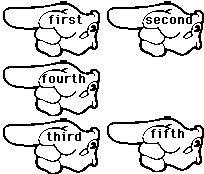

# 5
Conditions
This is an in-class test to be completed from 6:00 pm to 9:00 pm on Tuesday, 7 May.
Please write each solution in the blank or in the space provided under each prob lem situation. Use additional sheets of paper only as necessary. In evaluating your work, I need to be able to determine how you have solved each problem as well as any assumptions you have made. Leave a mathematical trail for me to follow.
You may not share work with others but you may use other resources (notes, textbook, worked exercises, and so on). You may use a calculator. You may express solutions in factorial notation or other combinatorial symbolism.
Impact on Grade
The semester exam accounts for 20% of your course grade.
Evaluation Criteria
You may earn up to 15 points for each problem. For each solution:
€ 12 points count toward a correct solution to the problem: Here I will consider the mathematics you use. Is it accurate and appropriate? Have you provided justification for your work?
€ 3 points count toward how you express your solution: Here I will consider how you communicate your solution. Is it clear
and complete? Is it well organized?
1. While lounging in the lobby of the Embassy Suites hotel in San Diego, I watched hotel employees open a door after
entering a code by pushing a digital keypad. The keypad is similar to the one shown here.

From my vantage point, I could see neither the door nor the keypad. I could see people pushing buttons from the side. After
carefully watching several people enter the door, I concluded that the sequence of keystrokes they used looked like the
figure shown below.

€ I knew the order of the keystrokes, as indicated by "first, second" and so on shown here.
€ I did not know which keypad was struck first.
€ I did know that the fourth push was directly below the first and second, and that the third and fifth pushes were directly below the fourth.
Based on this information, determine the number of different 5-number codes that could possibly unlock this door.

1. Consider the letters in the word purchase.
a. How many unique arrangements exist for the letters in the word?
b. If an arrangement must begin with a consonant and end with a vowel, how many unique arrangements exist for the letters
in the word?
a. Determine the number of uncollected terms in the expansion.
b. Determine the number of collected terms in the expansion.
c. Determine the coefficient P of the collected term PD^6A^2Y^8.
d. How many collected terms in the expansion will have the numerical coefficient P that you determined in (c) above?